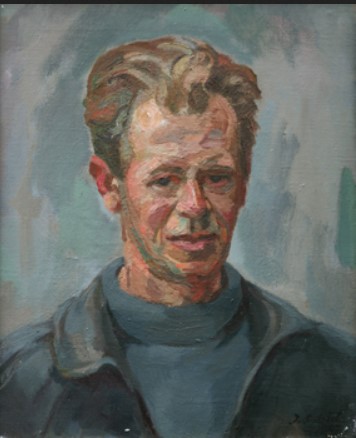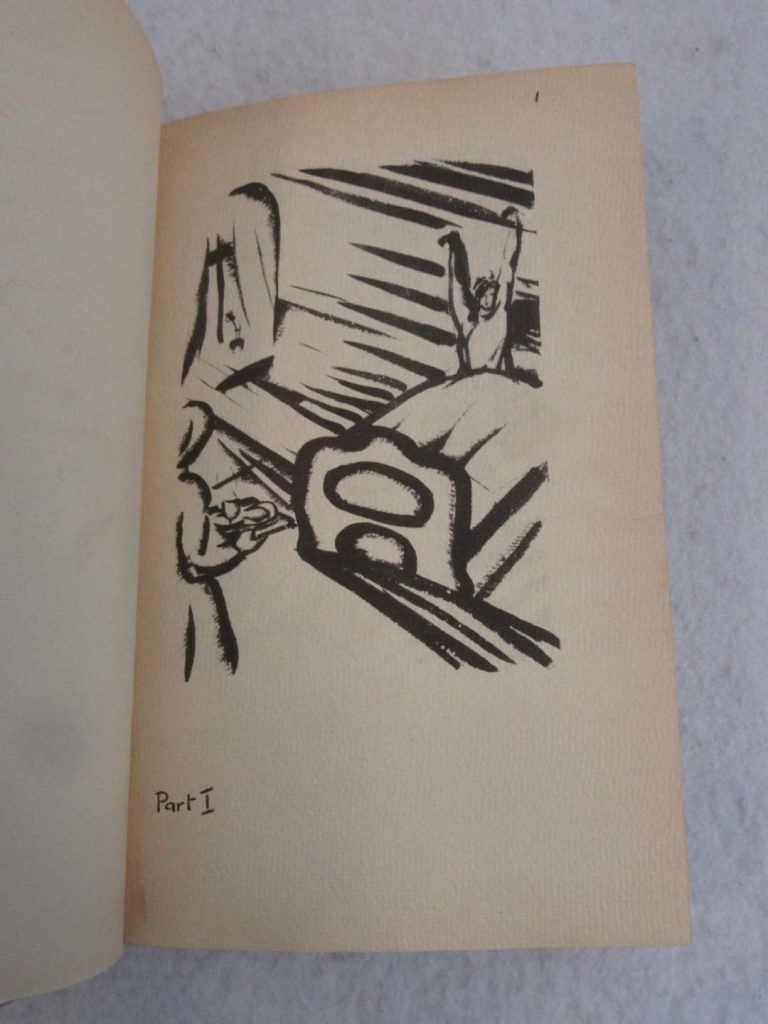Szuts’ wordless novel, My War, details the initial enthusiasm of a youth going off the war who is then ground down by the reality of war and its atrocities. It arises from Szuts’ experiences in World War One.
Istvan Szegedi Szuts (1892-1959) born in Budapest, Hungary.

- a friend of composers, Bela Bartok Zoltan Kodaly and Gyorgy Ranki.
- Szuts served in the First World War
- in 1929 he first visited England and held a solo exhibition at the Gieves Gallery, London.
- in 1931 he produced a wordless story, My War, using 206 images inspired by his war experiences (published in 1931 by John Lane).
- In 1936 he moved to Cornwall with Helen Gwynedd Jones-Parry, whom he married in 1937. The couple lived at Caunce Head near Mullion on The Lizard and remained there for the rest of their lives.
- He exhibited with The Newlyn Society of Artists and The Penwith Society of Arts.
My War
My War is a wordless novel composed of reproduced pen-ink-wash drawings by Szuts.
STORYLINE
Szuts begins with a carefree youth who goes gaily off to war and glory, leaving his family and his girl behind him. Trained to fight on a parade ground, he finds a battlefield bewilderingly different. We follow him through battle, see him wounded and on leave. There he finds bread lines, hordes of unemployed, his sweetheart in the arms of another. Back in the trenches, he finally cries out: “Stop killing”. He is arrested, tried, and shot… there is a secondary hero, a middle-aged peasant and his wife and family. The 2 stories run parallel.
From the inner front dust jacket flap of the NY publication.
This story of (over) 200 ink and brushwork drawings is a display of the atrocities of war as seen through the eyes of a Hussar, or cavalryman, named Isikos. In the table of contents, each page is given a title that provides necessary clarification to a narrative that would otherwise be difficult to understand.
Extract from: Wordless Books, The Original Graphic Novels; Beronä, David A., 2008 p.177
NOTE: Beronä is mistaken when he states, “cavalryman, named Isikos”. The Little Hussar and the isikos are two separate characters in this story, each with their own story arc. Image 20 is titled, “Nearby is the cottage of an isikos (farm-labourer)”. That is, the isikos lives nearby the parents of the Little Hussar. Later in the story the isikos is wounded and goes home while the Little Hussar continues in combat and later is awarded a medal for his fighting.
My War – the original drawings (pen, ink, and wash)
My War 1931 London, Bodley Head
My War 1932 NY, William Morrow & Co.
My War 2015 Dover NY
Apparently 13 editions of My War were published between 1931 and 2015 in English and other languages, including:
3 editions published in Hungarian; Budapest, Magyarország
- 1935 Hungary (Az én háborúm) Anyone with information about these – Please contact us at wn@wordlessnovels.com
The Little Hussar?

The “Little Hussar” is the main protagonist in the book. It is unclear why Szuts used the adjective “Little”.
- “Hussar” is traditionally used to refer to a member of a light cavalry unit.
- The protagonist in the story joins to fight in the war and at one point is decorated.
- perhaps “little” is a reference to his youth.
A note of thanks to Crispin Elsted of Barbarian Press, Mission, British Columbia for his expertise and patience when I was pestering him with questions about the printing process and information about the UK publishers.
Index of Image titles
PART I1 The Little Hussar wakes up
2 Happy youth
3 Father
4 Mother
5 Breakfast
6 Breakfast
7 Waiting for his master
8 Time for herding the sheep
9 The rider to the horse
10 Through the morning dew
11 Spring
12 Out of the village
13 Through the puszta (prairie)
14 Love is waiting
15 Expectance
16 Awakening
17 Flowers are speaking
18 Earth is speaking
19 The sun is speaking
PART II
20 Nearby is the cottage of an isikos (farm-labourer)
21 Within
22 The breadwinner
23 Approaching storm
24 His daughter, mistress of the geese
25 Sunset
26 Declaration of war
27 Recruiting
28 Mars
29 Off to the war
30 Dream of Heroism.
31 Goodye, isikos!
PART III
32 Amulet for the Little Hussar
33 Mirror
34 Au revoir
35 Hurry up!
36 It’s a long way…..
37 ……to Tipperary.
38 Passing by
39 Good Luck!
40 Daddy, daddy!
41 Off to camp
42 Freedom ended
43 The Serjeant-Major
44 Inspection
45 Who are you?
46 Sergeant-Major-once more- and always
47 Glorious war!
48 To a handsome officer belongs a handsome horse
49 Rain-never mind!
50 Twenty miles-never mind!
51 “….am always thinking of you….”
52 Noble horses…..
53 Faithful horses….
54 His great deed
55 Balloon’s down
56 Attack
57 Mice
58 Hide your face, mother!
PART IV
59 Isikos is wounded
60 Pain
61 Casualty clearing station
PART V
62 Gratitude to the doctors
63 The Little Hussar takes prisoners
64 Glorious progress
65 For valour
66 Christmas eve
67 Celebrating
68 Merry-making
69 Night-walk
70 No Christmas tree for me?
71 For anybody
72 The cross
73 Dawn
74 Decorated
75 Marching on
PART VI
76 Isikos’ wife plowing
77 A letter
78 Bad news
79 At the hospital
80 Family
PART VII
81 The Little Hussar is homesick
82 The Camp-fire
83 Dawn
84 “For God and Country….”
85 And they follow
86 An order to be carried out…..
87 …over the mountains…
88 …miles and miles.
89 In the trench
90 Thunder
91 Death the mower
92 Advance
93 Push on!
94 Fireworks at night…
95 …..until dawn.
96 No more harm ….?
97 No end-yet!
98 Goes on
99 Wounded
100 Is this the end?
101 The vision of the Little Hussar
102 The ride of death……
103 …over sleeping children
104 Mercy!
105 Flight to heaven
106 Children’s prayer…..
107 Stop the war!
108 Women implore…..
109 Stop the war!
110 Awakening
111 Pangs of pain
112 Looking around…..
113 … Comrades…..
114 …fathers…sons…..
115 …brothers…
116 …all heroes!
117 Death knocks again
118 No escape
119 Haunted-
120 Through flowers-
121 Through his native village-
122 Thrown off
123 Martyred Woman.
124 The very hero
125 Gratitude
126 Escape to rest
127 Hospital train
128 Letter from home
129 The Letter:-“….Enemy….
130 “…approach…
131 “…to her home…
132 “…plundering…
133 “…booty…
134 (“…………)
135 “…Community….
136 “…fire…
137 “…plundering…
138 “…his beautiful home….
139 …his beautiful village…
140 “…homeless parents…
141 “…disgraced….
142 “…job in town…
143 “…sensation….
144 “…career.” Letter ends.
145 The Little Hussar re-convalescent.
146 Acquaintances.
147 Audience
148 Misery.
149 Waiting for bread.
150 Mothers.
151 The prisoners’ tower.
152 Waiting for food..
153 Behind the gates
154 To the theatre.
155 Very attractive.
156 Is it her?
157 It is her.
158 Flowers for her.
159 Man’s voice inside.
160 Withering is your destiny.
161 She is no more his.
162 Café.
163 Dance.
164 Dancers
165 Loneliness
166 Homeward
167 The deserted village
168 Home
169 At his parents’ grave
170 Back again……
171 …looking backward…
172 …to this.
173 Forward!
174 Stop killing!
175 Revolutionary
176 What’s the use of killing?
177 Who are…
178 …these…
179 …who commands us to kill?
180 Stop it!
181 War profiteers!
182 Think…of your family.
183 You have been decorated
184 I am decorated
185 We are decorated
186 We are all decorated…..
187 …all decorated.
188 Hear! Hear!
189 Arrested
190 Degradation
191 Sentence of death
192 Purgatory
193 Remembrance
194 Thinking of his love….
195 …and those evening walks.
196 Hopeless
197 Man’s sensation
198 Curiosity
199 Spectators
200 Execution
201 No title. Not indexed in the book.
202 No title. Not indexed in the book.
203 No title. Not indexed in the book.
204 No title. Not indexed in the book.
205 No title. Not indexed in the book.
206 No title. Not indexed in the book.
COMMENTS
If you disagree with something on this page, have an improvement, or have a comment please contact me
wn at wordlessnovels.com
Any information used will be given a credit line.